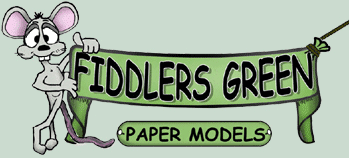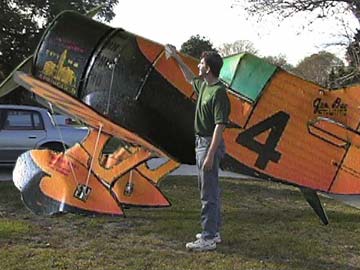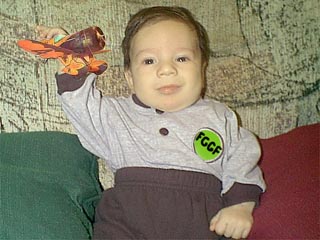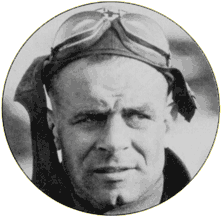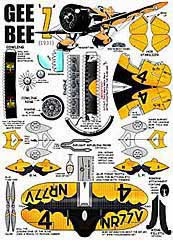
Granville Brothers and the Gee Bee Z
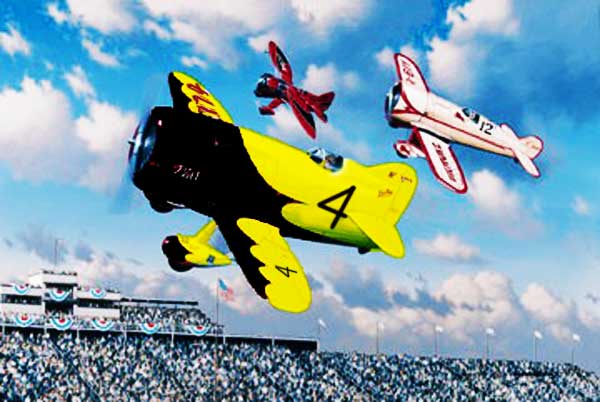
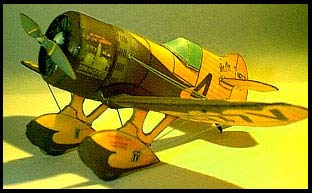
This model was built, photographed, and sent in by my friend Chauncy. He's the clever chap who designed the free download stand that does such a good job displaying Fiddler Green models. Thanks Chauncy.
The Gee Bee Model Z: was the first of the legendary Thompson Trophy winners making it's debut in 1931. It won that year's race at the average speed of 236 mph. In a later attempt to break the existing world's speed record, it hit 281.9 mph but broke up in the air killing it's noted racing pilot, Lowell Rayles.
Looks like Chauncy chose to display this model without the in flight refueling probe that's included with the model pictured on the right. The probe was cleverly engineered to be dual purpose and used by the US Navy (in the mid 30s) to hook midair onto the Shenendoah Airship as a possible alternate to the Sparrow Hawk biplane...Chip
I put together the GeeBee Z with some modifications. 2X larger version design and built in Beer can, 4X6 wooden prop, Flight Stabilizing System, Scale pilot, U-control and then powered with a COX 0.10 engine. The Results? 28 kph speed, above 3 minutes flying and very aerobatic racer hehe... thanks
Fiddlers Green, good plane!!! Luis
This Gee Bee Z is the model that won the FG Modeling Madness (FGMM) 2010 best in class prize. Thanks to Chris Walas who donated his $20 prize money toward modeling materials for hospitalized vets!! |
|
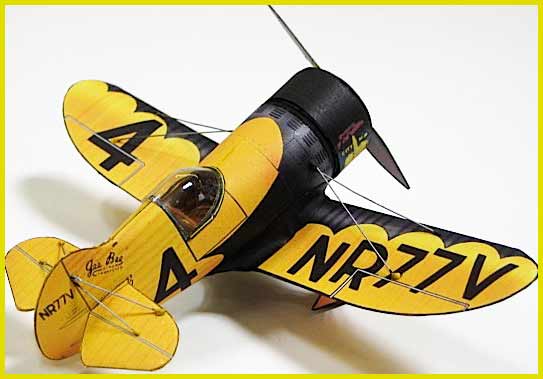 |
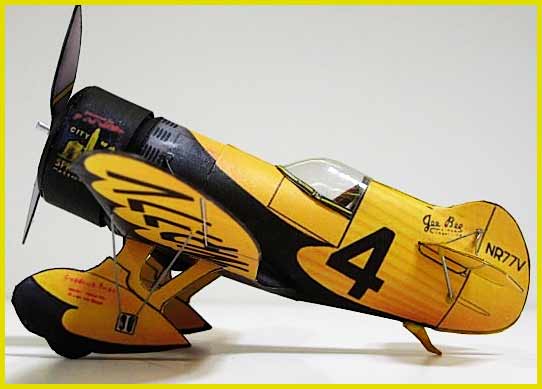 |
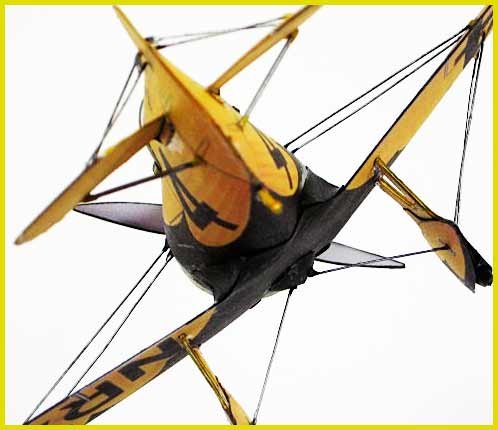 |
This one has been sitting on the pile for at least a couple of years now and I hadn't built it before because this is an early kit and I was leery of the fit, which isn't bad. The only changes I made were a vague interior, clear canopy, Styrofoam wheels, wire rigging and tail skid. I'm happy with the final model, it's just such a great looking plane! -Chris |
Thanks to 'Air' Dave Winfield !! |
|
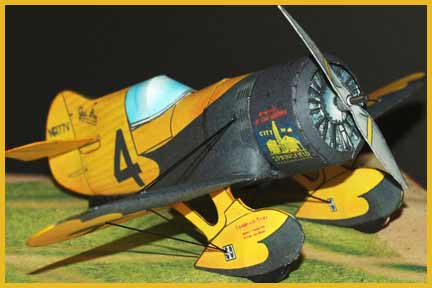 |
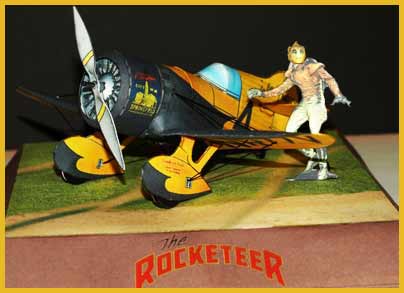 |
 |
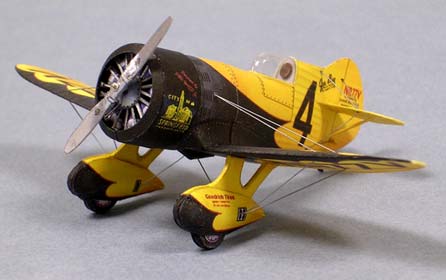 |
|
Here are some good quality pictures of your Gee Bee Z you may like. It is in 1/72 scale (fuselage is about 2.75-inches long) with some tweaks of mine you may notice. It's a cutie ! A blister cap from a cold
pill would have worked for the canopy, IF I made the plane
a little bigger. As it happens, I had to make it by heat
stretching some plastic over a female mold I made. Never
an easy out. My advice if someone wanted to use a blister
cap or something on hand for the canopy, first scale the
plane to fit it ! Dr John Glessner |
Gee Bee Model "Z"
History and comments on the Gee Bee
Racing airplanes and the Grandville Brothers
History and comments on the Gee Bee
Racing airplanes and the Grandville Brothers
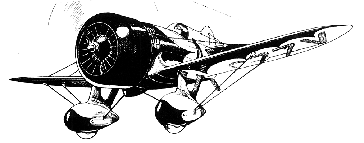 SEPTEMBER 7, 1931. Eight racing aircraft, some of the fastest
land planes in the world, were lined up for the start of the Thompson
trophy race at Cleveland, Ohio. The field consisted of Lowell
Bayles in a Gee Bee Model Z, Jimmy Doolittle in his Laird "Super
Solution", Jim Wedell in a Wedell-Williams Special, Ben O.
Howard in his Howard "Pete", Dale Jackson in a Laird
"Solution", Bill Ong in a Laird Speedwing, Ira Eaker
in a Lockheed Altair, and Bob Hall in a Gee Bee Model Y. The Thompson
was a ten lap race of 100 miles and was the climax of the National
air races.
SEPTEMBER 7, 1931. Eight racing aircraft, some of the fastest
land planes in the world, were lined up for the start of the Thompson
trophy race at Cleveland, Ohio. The field consisted of Lowell
Bayles in a Gee Bee Model Z, Jimmy Doolittle in his Laird "Super
Solution", Jim Wedell in a Wedell-Williams Special, Ben O.
Howard in his Howard "Pete", Dale Jackson in a Laird
"Solution", Bill Ong in a Laird Speedwing, Ira Eaker
in a Lockheed Altair, and Bob Hall in a Gee Bee Model Y. The Thompson
was a ten lap race of 100 miles and was the climax of the National
air races.
As the starter's flag dropped, all conversation was lost in the roar of the eight powerful engines as the entries blasted toward the first pylon one mile away.
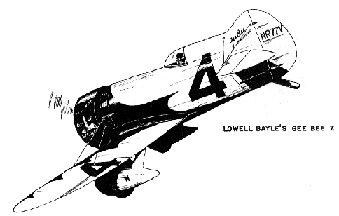 Doolittle was the first pilot to make the turn but soon his "Super
Solution" began trailing black smoke from a broken piston. Gamely he tried
to hold his position. On the second lap, Bayles in his Gee Bee Z, "City
of Springfield", took the lead. Dale Jackson had a narrow escape from tragedy
as he brushed a tree, but he continued to race. Bayles continued to extend his
lead. On the seventh lap.
Doolittle was the first pilot to make the turn but soon his "Super
Solution" began trailing black smoke from a broken piston. Gamely he tried
to hold his position. On the second lap, Bayles in his Gee Bee Z, "City
of Springfield", took the lead. Dale Jackson had a narrow escape from tragedy
as he brushed a tree, but he continued to race. Bayles continued to extend his
lead. On the seventh lap.
Doolittle was forced to retire. Bayles roared across the finish line at an average speed of 236.2 mph, culminating a week of triumphs for the Gee Bee team. Bob Hall finished fourth in the Model Y at a speed of 201 mph. The Gee Bees had nearly dominated the 1931 National air races and the Model Z had won every contest in which it was entered. The Granville brothers, the guiding spirits of the Gee Bees, returned to Springfield, Massachusetts, at one of the high points of their careers, unaware of the rocky road that lay before them in the years to come.
Mention the Gee Bee racers and most people recall only the many accidents that befell these aircraft and their pilots. Over the years, various articles have pictured these craft as "killers", "the most dangerous aircraft ever built", etc., and the inaccurate impression has been given that the Granville brothers were "backyard builders", simply adding more and more horsepower to inherently unstable airframes.
Actually several competent engineers were always on their staff, wind tunnel research was utilized and their construction methods were always of the highest caliber. Some crashes did occur through human error or on aircraft that had passed from the influence of the Granvilles. Unfortunately, it seemed that the Granvilles bore the brunt of criticism for factors beyond their control. Irresponsible members of the press equated the name "Gee Bee" with spectacular crashes.
The children of Wilfred and Belle Granville, Zantford (Granny), Robert. Tom. Edward. SIark and sisters Pearl and Gladys, were originally from Madison, New Hampshire. Granny, the oldest child, was a self-taught automobile mechanic with an eighth-grade education who had an affinity for anything mechanical and thrived on hard work. When Granny was 17 he moved to the Boston area where he took a job selling Chevrolets. A year later he established an auto repair business in Arlington where he sold Chevrolets and did service work. At the age of 20, he appeared at the East Boston airport where he exchanged his services as a mechanic for flight instruction.
Leaning more and more toward aviation, in 1922 Granny summoned his brother, Tom, to run the auto repair business while he went to work as a mechanic with the Boston Airport Corporation. Deciding to go into business for himself. he established Granville Brothers Aircraft and was joined shortly thereafter by his three remaining brothers. Granny's mechanical sense told him that he could improve upon the designs of many of the craft on which he was working. He and his brothers spent their spare time building a side-by side biplane powered by a 55 hp engine that they had bought for $500. Known as the Model A, it had its first flight at 5:30 a.m. on May 3, 1929.
Searching for adequate facilities to manufacture their biplane, the Granvilles contacted the chamber of commerce of Springfield, Massachusetts, on May 17, 1929, and on July 6 finalized plans to locate at the airport there. Hoping to attract backers to finance production of their Gee Bees, they entered their first air meet at Springfield on July 10. Here they met the four Tait brothers, James, Harry, Frank and George, owners of Springfield's biggest ice cream and dairy business, as well as developers of the Springfield airport. George Tait handed Granny a check for $1,000 and told him to come back after he had put "a real engine" in their plane. Returning to Boston, they purchased an Armstrong Siddeley "Genet" engine of 85 hp which greatly enhanced the performance of their prototype. A few weeks later, Granville Brothers was incorporated, building planes in an abandoned dance pavilion formerly named the Venetian Gardens at the Springfield airport.
Among the first workers on their staff were Albert Axtman, Austin Savary and Harry Jones. A secretary was hired and three college educated engineers were added to the rolls. These were the "Three Bobs", Bob Hall, Bob Ayre, and Bob Dexter, all of whom went on to successful careers in aviation. Fitted with a Kinner K-5 engine, nine of the Model A's were built and sold before the depression-plagued market dried up.
Hard times descended on the Granvilles. Ed and Mark rented an attic room and lived on beans which they purchased by the case. In the fall of 1929, few men had the money to purchase anything as frivolous as a personal airplane and the new corporation was on the verge of collapse when the All America Flying Derby was organized and sponsored by American Cirrus Engines, Inc.
This was to be the longest air race held in the world at the time-a 5,541-mile course that took the contestants from Detroit to Texas, west to California, and back to Detroit. All the entries were powered by one of the engines manufactured by the sponsor, either the Cirrus or Ensign engine. Eighteen entries competed in this event and the Granvilles were among them. The engineering team, spearheaded by Bob Hall, had produced the Model X, a trim little low-wing monoplane finished in black and white, powered by an American Cirrus engine supercharged by a Roots blower (positive displacement) to develop 110 hp at 2100 rpm. The Model X was flown by Lowell Bayles, a quiet, slim bachelor who was flying as copilot on the Fords the Tait's owned and operated between Boston, Springfield and Albany.
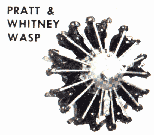 Bayles was born in Mason, Illinois. He had studied to be a mining engineer
but, after taking some flying lessons, was bitten hard by "the flying bug".
He bought a war surplus Jenny and joined the legion of barnstormers who were
attempting to eke out an existence by "hopping" passengers from the
pastures of America. In Leesburg, Florida, Bayles had met RoscoeBrinton and,
together, they had returned to Springfield where both became involved in aviation
activities, later teaming to form Brinton-Bayles Flying Service.
Bayles was born in Mason, Illinois. He had studied to be a mining engineer
but, after taking some flying lessons, was bitten hard by "the flying bug".
He bought a war surplus Jenny and joined the legion of barnstormers who were
attempting to eke out an existence by "hopping" passengers from the
pastures of America. In Leesburg, Florida, Bayles had met RoscoeBrinton and,
together, they had returned to Springfield where both became involved in aviation
activities, later teaming to form Brinton-Bayles Flying Service.
On July 21, 1930, the All America Derby began in Detroit. Ten of the entries completed the course and Bayles finished second, averaging 116.4 mph. The Gee Bee had demonstrated its dependability, although at one point Bayles had landed in a farmer's pasture and procured a piece of bailing wire to make some quick engine repairs. Lee Gehlbach won this event and later played a prominent role in the Gee Bee story, flying the larger and more famous racers.
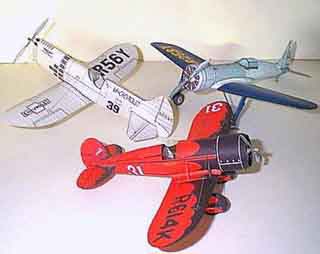 Bayles later bought the Gee Bee X, NR49V, and used it for his
personal transportation. Unfortunately, it was lost when Roscoe
Brinton was forced to bail out of it during an air show in New
Hampshire. Always the showman, upon being trucked back to the
field, Brinton mounted the platform and told the crowd, "You
wouldn't get a show like that in the National air races for what
you paid here."
Bayles later bought the Gee Bee X, NR49V, and used it for his
personal transportation. Unfortunately, it was lost when Roscoe
Brinton was forced to bail out of it during an air show in New
Hampshire. Always the showman, upon being trucked back to the
field, Brinton mounted the platform and told the crowd, "You
wouldn't get a show like that in the National air races for what
you paid here."
A total of nine of these Sportsters were built with a number of different powerplant's. Eventually those with in-line engines were referred to as Model D's, while those with radial engines were called Model E's. The official CAA report on the Menasco powered Sportster gave it the highest ratings in every respect. During certification tests it took off in nine seconds after a run of only 360 feet. Its rate of climb was 1,100 feet per minute. Prices ranged from approximately $4,800 to $5,500 depending on the powerplant selected.
|
|
The depression continued to plague the nation and Granville brothers was not exempt from the difficult times. It was a constant battle to keep their heads above water. In mid-1931, Bob Hall, the chief engineer of the fledgling corporation, mentioned the money to be made in racing contests such as the Thompson race. Hall was convinced that he could design a plane that could capture such a rich prize and work was begun on this project in the middle of July. Meanwhile, financial backing continued to be a problem. Hall pounded the streets by day seeking backers and toiled by night on the design and construction of the new racer. Finally, with sufficient funds, they formed the Springfield Air Racing Association with James Tait as president. One of their chief backers was Lowell Bayles, who had invested $500 for the privilege of flying the Model Z, as the racer would be designated. Actually the Granvilles had very little money invested in this ship. In these difficult times practically everything was furnished by the manufacturers. Tubing, dope, fabric, wheels, tires, and instruments were donated for advertising purposes.
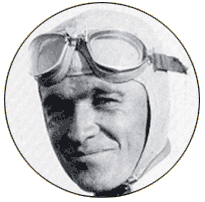 On August 22, 1931, Bob Hall's 26th birthday, the black and
yellow Model Z was rolled out of its hangar. Shorter and stubbier
than earlier models, it was already taking on the classic Gee
Bee appearance. Only 15 feet 1 inch in length, it was powered
by a Pratt & Whitney Wasp Jr., supercharged to 535 hp at 2400
rpm. The engine was loaned to the Granville brothers by Pratt
& Whitney. Bob Hall demonstrated his confidence in his design
by flying the first test flights despite his limited experience.
Christened "City of Springfield'', the Model Z was flown
by Bob Hall to the National air races at Cleveland where they
would learn the results of their labors.
On August 22, 1931, Bob Hall's 26th birthday, the black and
yellow Model Z was rolled out of its hangar. Shorter and stubbier
than earlier models, it was already taking on the classic Gee
Bee appearance. Only 15 feet 1 inch in length, it was powered
by a Pratt & Whitney Wasp Jr., supercharged to 535 hp at 2400
rpm. The engine was loaned to the Granville brothers by Pratt
& Whitney. Bob Hall demonstrated his confidence in his design
by flying the first test flights despite his limited experience.
Christened "City of Springfield'', the Model Z was flown
by Bob Hall to the National air races at Cleveland where they
would learn the results of their labors.
On September 1, Lowell Bayles, flying without shoes to improve his feel of the rudder. raced over the Shell qualifying course at an average speed of 267.342 mph. On one run he attained an unofficial world record speed of 286 mph while 100,000 spectators gasped in wide eyed wonder. The next day Bayles won the 50 mile Goodyear trophy race at a relaxed speed of 205.001 mph. Bob Hall, in Model Y, NR11049, had a close brush with death when he hit a water tank and clipped a few feet off a wing tip while turning on a pylon too close to the ground. This didn't phase him as he switched to the Model Z on September 5 to win the General Tire and Rubber trophy as Bayles rested for the upcoming Thompson trophy contest.
On September 6, Hall and the Model Z gained another first place for the Gee Bee team in a free-for-all race. Maude Tait, daughter of James Tait, captured the Cleveland Pneumatic Aero Trophy for Women in the Model Y at the speed of 187.57 mph, a closed course record for women. All of this led up to Bayles' triumph in the stellar attraction of the meet, the Thompson trophy race. The Gee Bees had cleaned up at Cleveland and shares in their venture that had originally sold for $100 were now worth five times that. The Granvilles returned to a victory parade and banquet in Springfield with cash in their pockets and a determination to go after the world's speed record and to ready themselves for the 1932 campaign.
First, the "City of Springfield" was fitted with
a new 750 hp Wasp Sr. R-1340 engine. Arrangements had been made
with the authorities at Detroit's Wayne County airport to set
up the speed course and Maude Tait would also make an attempt
at the women's record in the Model Y while at Detroit. On November
6, Bayles took off from Springfield to fly to Buffalo where an
8 foot 2 inch fixed pitch propeller was installed at the Curtiss
Reed plant. After the arrival at Detroit, Bayles made three attempts
at the speed record that were aborted as engine troubles plagued
the "City of Springfield". On one trial run he had attained
a speed of 314 mph and prospects of a record performance appeared
good. Only the average of four runs could be given record consideration,
so the speed mark continued to elude them. Maude Tait was equally
unsuccessful and returned to Springfield for her marriage to Attorney
James P. Moriarty.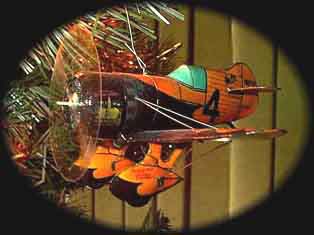
On November 30, Bayles was ready for another assault on the record. This time it was the failure of the timing cameras that stymied Bayles despite the fact that he attained a speed of 284.5 mph on one of his runs.
On the afternoon of December 1, 1931, Bayles again went after the elusive speed record, making four runs over the F.A.I. 1.8 mile (3 km) course. The existing world's record was 278.4 mph and it was necessary to surpass this by 4.97 mph to claim a record. For a while it appeared that he had achieved 284.7 mph, but a recheck on December 2 showed an average of 281.75, so once more the record slipped from their grasp.
On December 5, the 31 year old Bayles was ready again. Shortly after 1 p.m. he took off and climbed to 1,000 feet to start his dive for the run which had to be made below 162 feet. Roaring into the three-kilometer course at approximately 150 feet above the ground, the Gee Bee was traveling at tremendous speed when the plane suddenly pitched up sharply and the outer half of the right wing folded back. The aircraft did two and a half fantastically fast snap rolls and crashed in a ball of flames. The wreckage was scattered over 600 feet and the shy, slim Bayles was killed instantly. Ironically Bayles was to have been married on December 13 to Miss Gertrude St. Marie of Newton, Illinois. His death was a terrible shock to all involved since he was like one of the brothers and had exhibited great faith in the aircraft.
A motion picture of the crash was examined frame by frame and the final conclusion was that a loose gas cap had caused all the trouble. Apparently it had vibrated loose, crashed through the windshield and incapacitated Bayles, at least breaking his goggles and possibly rendering him unconscious. It was here that the sudden change of attitude occurred. According to designer Hall, the plane was sensitive longitudinally and the sudden change of pitch caused the wing to fail. Pieces of the canopy, part of Bayles' goggles and the gas cap found along the flight path seemed to support these findings.
It must be reemphasized that the Granvilles were not amateur experimenters who simply threw together a succession of aircraft with bigger and bigger engines. Granny always knew enough to attract highly skilled workers to their organization and on their staff were such competent aeronautical engineers as Bob Hall and Howell Miller. Although construction methods were of the highest order it seemed that the Gee Bees were often plagued by human errors, material defects or careless maintenance that brought these high-performance aircraft to grief.
It was only a slight consolation when an exception was made to the regulations to posthumously award the U.S. national land plane speed record of 281.75 mph to Lowell Bayles on January 14, 1932, for his flights of December 1, 1931. Although an air of gloom descended on the organization at their first loss, plans went ahead for the 1932 campaign.
Engineer Bob Hall had left the Granville camp at the end of November 1931. Russell Boardman, famed long-distance flyer, bought a controlling interest in the Springfield Air Racing Association and planned to pilot one of the two planes that the Granvilles were planning for the 1932 races which would be held at Cleveland from August 27 to September 5. For these races the Granvilles, along with their new chief engineer Howell W. Miller, built two planes, the R-1, begun in May of 1932, wore racing Number 11, and the R-2 wore Number 7. Number 11 was powered by an 800-hp Wasp Sr. T3D1, while Number 7, designed for longer races such as the Bendix transcontinental, had a larger gas tank and a 550-hp Wasp Jr. Both had controllable pitch propellers, among the first used in racing. Russell Boardman was chosen to fly Number 11, and eventually Lee Gehlbach would pilot Number 7.
|
Chauncy's Christmas Tree '01. Thanks guy! |
|
Boardman was born near Middletown, Connecticut, on January 22. 1898, and had purchased his first plane in 1921. For a while he took over the Hyannis, Massachusetts, airport and had operated a seaplane line from Boston to Hyannis. On July 28, 1931, along with John Polando of Lynn, Massachusetts, he had flown a Bellanca from Floyd Bennett field in New York to Istanbul, Turkey, to establish a distance record of 5,011 miles. At the Omaha air races in May of 1932, he won a free for-all race in the Gee Bee Model Y that Maude Tait had raced in 1931. The following day he demonstrated his versatility by winning the Charles Holman acrobatic trophy.
Demonstrating the scientific nature of their research, the Granvilles constructed a wind tunnel model of their barrel-fuselage racer and had it subjected to tests in the New York University wind tunnel. A year later, on May 18, 1933, Granny and his chief engineer, Howell W. Miller, presented a paper to the Society of Automotive Engineers in New York City describing the design and construction of their now-famous racers. Obviously they felt that they had two sound, viable contenders for the prizes offered in the upcoming races.
On August 10, painter George Agnoli finished the fancy scalloped red and white paint job on the R-1. On the 12th it was rolled out of its hangar to sit gleaming in the sunshine. Final adjustments postponed the first flight until the following day. On August 13, shortly after nine o'clock, Russ Boardman took off his coat, slipped on a parachute and flew the R-1 to the Bowles Agawam field across the Connecticut river. The performance figures were exhilarating. The R-1 had hit 240 mph without half trying and Boardman felt confident that 300 mph was well within reach.
Robert and Granny Granville were at Bowles when Boardman landed from the first test flight. As they opened the door of the plane, Boardman looked up at them, grinned and said, "You boys sure build airplanes." His only complaint was that the ship fishtailed during landing approach and apparently did not have enough fin area. Work was immediately begun to rectify that problem by adding two square feet of fin area and an increase in rudder area to match the added fin.
On Tuesday, August 16, Boardman was severely injured as he spun a Model E Sportster into the trees on the Carew street side of the Springfield airport as he was flying to Agawam to complete the tests on the revamped R-1. With two weeks remaining before the start of the races, neither aircraft had a pilot. Applications flooded the Granvilles from every pilot in the country who had any ambitions of appearing in the Cleveland races. Finally, on August 22, Lee Gehlbach was chosen to fly the R-2. He would ferry the R-2 to Burbank to fly the Bendix race from there to Cleveland. Oil temperature problems were already starting to show up which would plague the R-2 over the next few weeks. Earle Boardman, Russ' brother, was prepared to fly SIark and Ed Granville to Los Angeles and Kansas respectively to supervise the refueling of the R-2 during the Bendix race.
A stroke of fate interjected a new name into the Gee Bee saga. At Wichita, Kansas, Jimmy Doolittle was test flying his Laird "Super Solution", which had been extensively modified for the 1932 races. When he found that he couldn't get the wheels down, he was forced to belly his aircraft in, eliminating it from further competition, but emerging unhurt. On August 27, when it was apparent that Russ Boardman would be unable to compete in the National air races, Granny made telephone arrangements with Doolittle for him to fly the R-1. On August 28, Doolittle arrived at Springfield. While everyone expected him to take a turn or two around the field to familiarize himself with the new aircraft, dubbed by the press as "The Flying Silo", he simply climbed in, headed west and never altered his course. Less than two hours later the Granvilles received a telegram stating simply, "Landed in Cleveland O.K., Jim."
Lee Gehlbach indicated his confidence in Number 7 when he told members of the press, "Number 7 is the most wonderful handling ship I've ever flown. Doolittle added his praise of Number 11 by stating. She s got plenty of stuff. I gave her the gun for just a few seconds and she hit 260 like a bullet without any change for momentum and without diving for speed and she had plenty of reserve miles in her when I shut her down.
Only four planes were entered in the Bendix race from Burbank to Cleveland and Gehlbach had to be considered as one of the pre-race favorites, but engine troubles plagued him all across the country. Robert Granville recalls that "The Gee Bee was throwing oil so badly that Gehlbach landed in Illinois and removed the oil splattered canopy so that he could see." He finished a disappointing fourth, an hour and twenty minutes behind the winner, Jimmy Haizlip, who was flying the Wedell-Williams Special No. 92.
Doolittle fared better in the Thompson trophy race. On September 5, nursing a hay fever attack, he blazed around the pylons at a winning speed of 252.686 mph. Among those who witnessed his victory were his two sons, ten year old John and James Jr. Lee Gehlbach finished fifth, and Bob Hall, the former Granville engineer, was sixth in the field of eight in his Springfield "Bulldog" racer.
While at Cleveland, Doolittle set a world's land plane speed mark over the regulation F.A.I. three kilometer course that had been set up for a series of speed dashes sponsored by the Shell Oil Co. On August 31, the 35year-old Doolittle averaged 293.193 mph on four runs over the speed course but this did not qualify as an official record since he didn't have a barograph in the plane to confirm that he was below the required 162 feet (50 meters) during his runs. He subsequently made four more runs on September 1, averaging 282.672 mph, just .77 mph short of that required to claim a new record. On his final run it appeared to the horrified spectators that he was about to brush some trees just north of the field. Later Jimmy said, "I was nowhere near them. I must have been at least four feet over them."
At the Eastern States Exposition in September of 1932, Jimmy, in speaking of Z. D. Granville. said, "He builds a most excellent airplane and it was the airplane that did the job." Finally, in a letter dated September 7, 1932, and addressed to Granville Brothers Aircraft. Doolittle commented, "Just a note to tell you that the big Gee Bee functioned perfectly in both the Thompson trophy race and the Shell speed dashes. With sincere wishes for your continued success, I am, as ever, Jim.
Preparations were immediately started for the 1933 races. Number 11 was fitted with a P& W Hornet and a rudder with increased area. Number 7 had the Wasp Jr. replaced with a new Wasp Sr. and the old engine cowl from the R-1. A new wing with greater span and chord was installed as well as a larger rudder, identical to the new R-1 rudder. AISO7 in 1933, work was begun on the design of a two place, long range racer to be built for Jacqueline Cochran and designed to compete for the $48,O00 purse offered in a London-to-Melbourne race scheduled for 1934. This plane was called the Q.E.D., from the Latin phrase, "quod erat demonstradum", meaning that the solution of a given problem has been demonstrated. However, it would be tragically demonstrated that all the problems associated with high speed flight had indeed not been solved.
The 1933 National air races were to be held in Los Angeles from July 1 through July 4, with the finish of the transcontinental Bendix race from New York as one of the highlights. After being received at City Hall on June 6 by Mayor O'Brien of New York, Boardman, now recovered from his earlier injuries, and 22-year-old Russell Thaw, in the re-engine R-1, and the modified R-2, left Floyd Bennett field on the morning of July 1, 1933 along with Roscoe Turner, Lee Gehlbach, Jim Wedeli and Amelia Earhart. Thaw took off at 5:52 a.m. and Boardman followed, being the last to depart. Thaw used almost the entire length of the field, dragging his tail wheel as he struggled to get his heavily laden plane into the air. Boardman, with a lighter load and higher horsepower, made a perfect take-off and streaked westward.
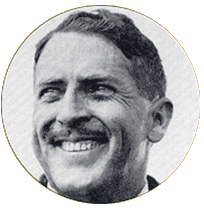
Boardman and Turner had announced that they would refuel in Indianapolis while the others would let their fuel consumption govern their landing places. Preliminary plans called for Thaw to land at St. Louis and Amarillo, but his high rate of fuel consumption caused him to land at Indianapolis. Turner arrived at Indianapolis at 6:06 a.m. and within ten minutes he was once more winging his way westward. Thaw was the next to land. Contrary to many published reports, he made a perfect landing. On all earlier Gee Bees the Granvilles had manufactured their own shock struts. Now their racers were equipped with a commercially manufactured strut. In making a rapid 180-degree turn to get back to the refueling area, one of these struts collapsed and the left wing tip was damaged near the outer aileron hinge as it struck the runway.
Since it looked as if the damage could be readily repaired, the plane was wheeled into a hangar and work was begun to restore it to flying condition. Boardman was the next to arrive and he chatted with Thaw as his plane was refueled. Then he took off with 200 gallons of fuel on board. At about 40 feet in the air, he lost control of Number 11, and it flipped on its back and crashed, fatally injuring Boardman, who died on the morning of the 3rd, leaving a wife and four-year-old daughter, Jane. Thaw was so shaken that he withdrew from the race at that point.
The other entries were also plagued with misfortune. Lee Gehlbach, flying a Wedell-Williams racer, was forced to land near New Bethel, Indiana, with a clogged fuel line, crashing through a fence but emerging unhurt, and Amelia Earhart, in a Lockheed Vega, was forced down in Kansas. Roscoe Turner won the race in 11 hours and 30 minutes, picking up the $5,050 first prize plus $1,000 for setting a new East to West record. Wedell, who finished second, won $2,250.
It was a horrible blow for the Granville brothers. In a few minutes they had lost both planes and one pilot. Robert Granville recalls, "I guess it was the point where our luck started to go bad."
Boardman's brother, Earle, also a pilot, was with him when he died. On July 4, he flew Russ' body east to Hartford, Connecticut, stopping to refuel at Syracuse, New York. On July 6, 1933, Russell Boardman was laid to rest in the Miner cemetery in Middletown, Connecticut, while six planes circled overhead and dropped flowers. Among those present was John Polando of Lynn Massachusetts, with whom Boardman had made his long distance flight to Turkey.
Granny repaired Number 7, but within a few days Jim Haizlip cart wheeled it across the Bowles Agawam field. Although he was uninjured, the plane was a total loss. One more tragedy took place in 1933 that reflected unfairly on the reputation of the Granvilles. On September 4, 1933, the newest Model Y, NR718Y, originally built for the E. L. Cord Corporation, but now owned by Arthur Knapp of Jackson, Michigan, and being flown by 26-year-old Florence Klingensmith of Minneapolis in the International air races at Chicago, crashed and was destroyed. Originally powered by a 215-hp Lycoming R-680 engine, it now sported a 450-hp Wright J6-9 Wirlwind.
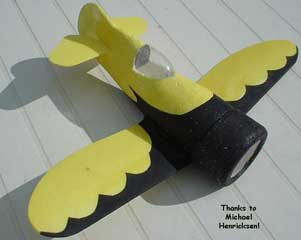 Miss Klingensmith was running with the leaders in the seventh
lap of the Phillips trophy free-for-all race when the fabric on
the right wing split between the first and second ribs. Although
Granny later insisted that this should not have affected the integrity
of the aircraft, she leveled off and flew to the southeast for
three miles before hitting a tree at the corner of Glenview and
Shermer Roads in Glenview, Illinois. She had evidently tried to
bail out at the last minute for her chute was deployed beside
her, but she had been killed instantly. Later, the remaining Model
Y, NR11049. formerly flown by Maude Tait, was lost when a propeller
blade broke, the engine tore loose from its mountings, and it
spun into the Atlantic Ocean after a take-off frDm North Beach
(now LaGuardia) field. Both of these planes had passed from the
influence of the Granvilles and had been modified by their new
owners, but the reputation of the Gee Bees suffered unfairly from
their loss.
Miss Klingensmith was running with the leaders in the seventh
lap of the Phillips trophy free-for-all race when the fabric on
the right wing split between the first and second ribs. Although
Granny later insisted that this should not have affected the integrity
of the aircraft, she leveled off and flew to the southeast for
three miles before hitting a tree at the corner of Glenview and
Shermer Roads in Glenview, Illinois. She had evidently tried to
bail out at the last minute for her chute was deployed beside
her, but she had been killed instantly. Later, the remaining Model
Y, NR11049. formerly flown by Maude Tait, was lost when a propeller
blade broke, the engine tore loose from its mountings, and it
spun into the Atlantic Ocean after a take-off frDm North Beach
(now LaGuardia) field. Both of these planes had passed from the
influence of the Granvilles and had been modified by their new
owners, but the reputation of the Gee Bees suffered unfairly from
their loss.
During the fall of 1933, Z. D. Granville, Howell Sliller, and Donald Delackner opened a consulting engineering office in New York City in the hopes of continuing development of certain commercial projects such as four, six and eight place airplanes. As far as racers went, they were left with the shattered remains of the R-1 and R-2. From the remains of the R-1 and the R-2 the Granvilles built another racer, christening the resultant plane "Intestinal Fortitude". It was known as "International Supersportster" Model R-3. The plan was for Roy Minor to fly it in the Chicago races of 1933.
After "Intestinal Fortitude" was assembled. Grannv planned to fly to San Antonio to deliver a Sportster that he still owned to a customer in that Texas City. En route. he planned to visit Florida and the Mardi Gras in New Orleans. Approaching a landing at Spartenburg. South Carolina, on February 12, Granny suddenly noticed that there was construction in progress and his only safe landing area was blocked by two workers unaware are of his approach. As he pulled up, his engine coughed and died and he spun in from 75 feet. The 35-year-old Granny died en route to the hospital leaving a wife and two children.
Shortly after Zantford's death, the Gee Bee organization was sold at a sheriffs sale. However, financial backing was found to continue work on the big Q.E.D. Wesley Smith and Jacqueline Cochran flew this plane in the MacPherson Robertson London-Melbourne race and made it as far as Bucharest, Romania. Here the aircraft was damaged in landing when the flap system failed to operate properly. Earlier in 1934, Lee Gehlbach had flown the Q.E.D. in the 1934 Bendix race. Plagued by cowl troubles, he arrived in Cleveland too late to even place in the race. As if there were not enough trouble, Roy Minor had stood the R-3, also known as the R-1/R-2, up on her nose in a drainage ditch in Springfield during some tests and that eliminated that aircraft from any of the 1934 events. With all its power, the R-3 had a tendency to float during landing, causing Minor to overshoot on landing and touch down at mid-field. Earlier a thunderstorm had drenched the field and he found he could not stop on the wet grass. The plane went up on its nose in the ditch, made one or two revolutions on its prop and then leaped over the fence to land upright on its gear in the adjoining street. Needless to say, Minor was thoroughly disgusted as he climbed out of the aircraft and tossed his helmet and goggles over the fence to the Granvilles, who had raced to see what remained of the aircraft. The resulting damage eliminated the ship from all competition during that year.
The Granvilles hoped to attract some military business by demonstrating the Q.E.D. throughout Europe. Although some demonstrations were arranged, no orders were forthcoming. Returning the ship to the United States, it suffered a landing accident while on a demonstration flight for some Chilean officials. Although no one was hurt, no orders resulted from that event. Indeed, with a little luck at this time and with the impending war, the Granvilles might have taken their place among the prominent aircraft manufacturers of the present era. But, unfortunately, whatever luck the Granvilles had was almost invariably bad.
The 1935 Bendix race saw two Granville entries. The Q.E.D. was flown by Royal Leonard and the composite R-3, renamed the "Spirit of Right", was to be flown by 33 year old Cecil Allen. Among Allen's backers were the Aero Educational Research Organization of Pasadena and the Religious Patrons Association. The R-3 had been modified by Allen. although the Granvilles could no longer directly exert any control upon its fate. Howell Miller had contacted Allen and offered to aid in its reconstruction. When he was ignored. he did stress to the new owner that in no case should the center of gravity be moved aft of 22 percent of the mean aerodynamic chord.
The 1935 Bendix race was from the Union Air Terminal in Burbank, California. to Cleveland. On August 30, Allen was the last to take off. following Benny Howard, the eventual winner, and Roscoe Turner, who was to finish second by only 23 seconds The "Spirit of Right" was decorated with the cartoon character "Filaloola" bird that had adorned the earlier successful Model Y, and the motto, "Over the Fence and Out", and that's a succinct summation of its performance.
Allen's plane, 22.5 feet in length with a 30 foot span, had not performed well in tests and careened crazily at the start of the Bendix. Staggering into the sky, Allen was only two miles from the field when he lost control and crashed in an open field. Allen had cut the ignition switch so there was no fire, but the two witnesses who raced to the scene found him dead in the cockpit. Allen had added some fuel tanks and had test flown the aircraft with only the forward tank filled. With the aft tank filled for this race, it was later computed that the center of gravity was approximately 35-37 percent of the M.A.C. Again the Granville name was defiled when, in fact, it should have been reported that "they told him so". The Q.E.D. fared only slightly better, making it as far as Wichita when engine trouble arose to prevent the fans at Cleveland from getting a glimpse of the Gee Bees in 1935.
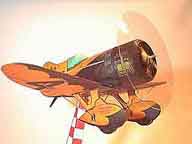
Chauncy's Gee bee Z model on his custom made display stand.
The Granvilles were now just about finished in the field of racing although Mark Granville and most of the workers at the Granville plant built a new racer for Frank Hawks. Sponsored by the Gruen Watch Company, it was called "Time Flies" and was one of the most streamlined aircraft of all time. A unique feature on "Time Flies" was that the pilot's seat could be lowered about 12 inches in flight, allowing the windshield to be retracted flush with the fuselage.
The Q.E.D. was left alone to carry the memory of the Granvilles to the leading air racing events that they had once dominated. Lee Miles flew the Q.E.D. in the 1936 Thompson trophy race, averaging over 200 miles per hour for the first 10 laps. Then engine trouble forced him to retire. The jinx of the Q.E.D. continued.
By 1938, the Q.E.D. was in the possession of Charlie Babb, a well known aircraft broker. After a complete overhaul of the plane, George Armistead, one of Babb's pilots, was named to fly it in the 1938 Bendix trophy race. Heading east from Burbank, Armistead was over Kingman, Arizona, when he noticed his oil pressure dropping rapidly and the oil temperature climbing at an alarming rate. Landing at Winslow, Arizona, he decided that there was no use in attempting to resume the race.
Charlie Babb then sold the Q.E.D. to Francisco Serabia, the president of TASCA, a Mexican airline. The plane was renamed "Conquistador del Cielo and registered as XB-AKM. Serabia called it the best plane I've ever flown". On May 24, 1939, he flew the plane from Mexico City to New York, covering 2350 miles in just 10 hours and 47 minutes. On June 7, Serabia was ready to leave Bolling field in Washington. D.C.. for the return flight to Mexico. As the plane roared out over the Potomac river, the engine missed and faltered and the plane plunged into the river. Serabia was trapped in the cockpit and drowned in 15 feet of water. Later it was determined that the cause of the accident was that a rag had been left inside the co~-l and had been sucked into the carburetor air intake.
Later, the Q.E.D. was salvaged with minimal damage. For a time it sat at a Mexican Air Force Base at St. Lucia. (In the 1960's. Alberto Sarabia, a cousin of Francisco Sarabia, had the Conquistador del Cielo" restored to like new flying condition. A round, domed museum to house the restored aircraft was built in Ciudad Lerdo, Durango, Mexico and the aircraft is presently enshrined in the middle of the room, surrounded by floodlights that illuminate the aircraft night and day. The museum is open to the public.) The surviving Gee Bee Model A, N9OlK, is in the collection of the Connecticut Aeronautical Historical Association at Bradley Field in Windsor Locks.
What has become of the principals of this story? Edward Granville worked for Pratt & Whitney in Connecticut for 40 years and retired in 1976 as Chief of Experimental Construction. In 1977 Ed died at his home in Silver Lake, N.H. Robert Granville was a foreman for Vought during World War II, supervising the construction of Corsairs and Kingfishers. In 1946 he moved to Maine where he purchased a large farm near Skowhegan. Having sold most of the farm, he and his wife, Eva, were living in North Cornwall, Maine, when he passed away on 13 Nov. 1978. Mark Granville was superintendent of the wind tunnel at Pratt & Whitney when he died of a heart attack in Somers, Connecticut, in the early 50's. Thomas Granville, who was a welding foreman at Kaman Helicopters, died in May of 1974 of heart trouble. Howell (Pete) Miller, the designer of the R-1 and R-2, is retired from Pratt & Whitney and lives in Manchester, Connecticut. Robert Hall retired from Grumman Aerospace Corporation as Vice President and now resides in Hilton Head, South Carolina. Maude Tait Moriarty still lives in Springfield, Massachusetts. Russell Thaw is reported to be a postmaster in a small Connecticut town. While Granny's wife, Alta, died in December of 1974, his son, Robert, works for Pratt & Whitney in Hartford while his daughter, Norma, is a medical doctor and blood specialist at a hospital in Hartford, Connecticut.
The old Springfield field is no longer there, having been turned into a shopping center, but the birth of the Granville aircraft at this site has not been forgotten. A large mural in a restaurant depicts the landing of a Gee Bee at the old airport and bears portraits of the five brothers. One wonders how many busy shoppers in a nearby department store pause to read a plaque erected in honor of the Gee Bees and the Granville brothers. Indeed, the Gee Bee racers will live forever in the memories of those who witnessed the flights of these remarkable aircraft.
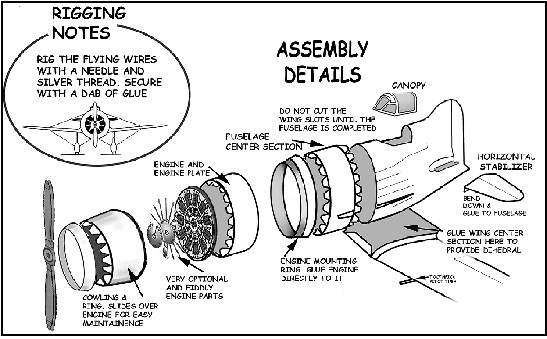
Specifications for the Gee Bee Model Z
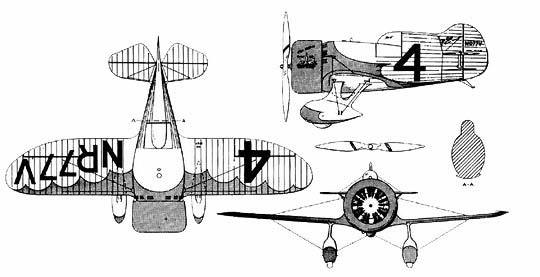 |
Length: 15 ft 1 in |
